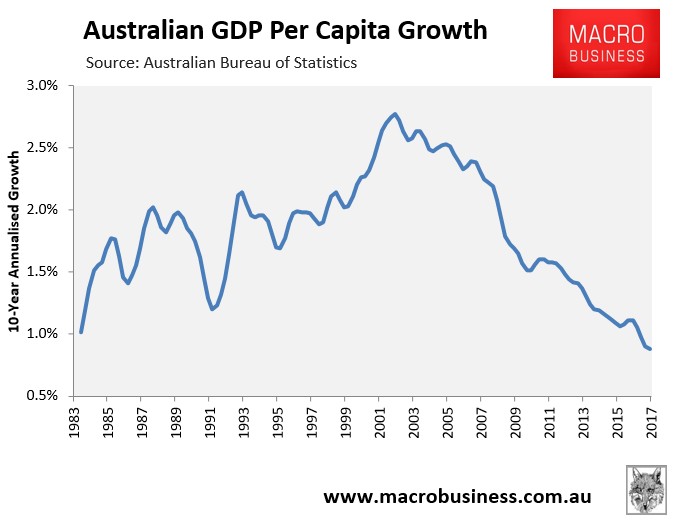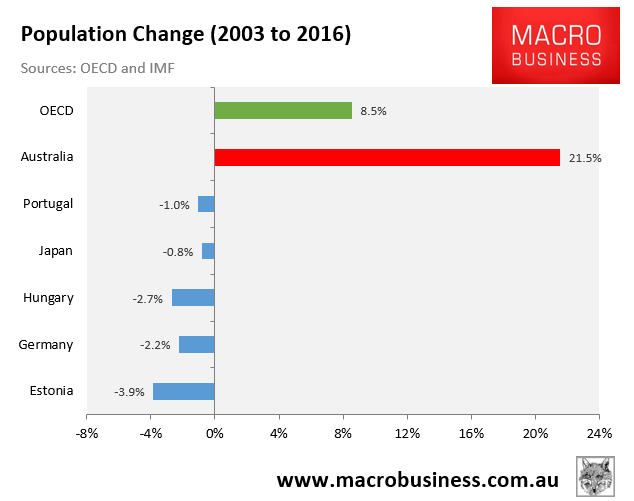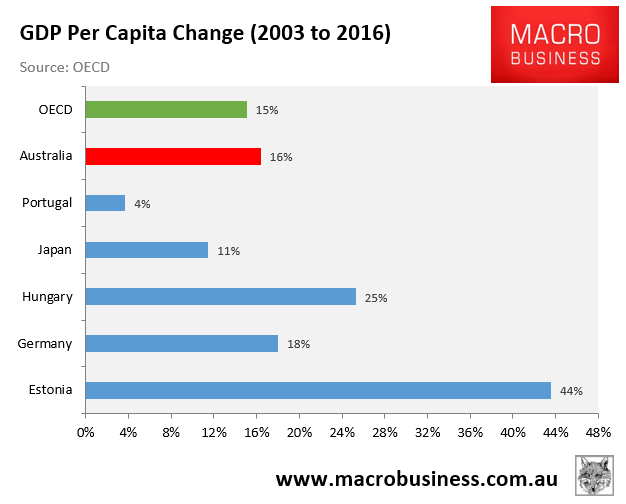The Australia Institute’s chief economist, Richard Denniss, has posted his second The Lucky Country podcast, which contained an interesting discussion on mass immigration and its impact on living standards:
Listener question: “I’ve heard arguments that letting refugees into Australia will actually help our economy as more people would mean there’s more people to spend money and consume. Therefore, boosting the economy. Do you think this is true?”
Richard Denniss: “This is a really important question. There’s no doubt that having more people move into a country will lead to GDP growth, which is a bit of econobabble for the total amount of stuff that’s bought and sold and produced in the country. So, whether we have big immigration in terms of skilled migration, big immigration in terms of family reunion, or big immigration in terms of refugees, if there’s more people in a country making stuff, selling stuff, buying stuff, then the amount of stuff that’s made, bought and sold will obviously be bigger.
So to be clear, there’s absolutely no doubt that rapid population growth – whether it’s in the form of skilled migration or refugees – will lead to an increase in the total amount of stuff bought and sold. But is that ‘good’ for the economy?
We usually talk about the size of the economy – GDP – when what really matters – if GDP matters at all – is GDP per person, GDP per capita. So, think of it this way: China’s got a much bigger economy than Australia, a much bigger GDP. But when you divide it by 1.3 billion people, GDP per person is much smaller than it is in Australia. And then you’ve got small countries like Monaco which have got a much smaller economy than Australia – much smaller GDP – but a very small and very wealthy population. So when you divide their total GDP by their population, their GDP per person is a lot higher than Australia’s.
So, you wouldn’t usually think that people in China are on average wealthier than people in Monaco because it’s actually GDP per person – GDP per capita – that matters to our day-to-day material standard of living.
So, the economics tells us that when more people come to a country, GDP will grow. That’s great for the shops that sell us our groceries, that’s great for the banks that give us our credit cards, that’s great for the people that want us to go to the movies – more customers. But in terms of our quality of life – GDP per person – the economic evidence suggests that population growth doesn’t really have much impact on GDP per capita at all. Indeed, some evidence suggests that rapid population growth is possibly even bad for average standard of living – GDP per person. Economists can’t agree on that, but what we can agree on is just because the population’s growing fast, and just because GDP is growing fast, it doesn’t mean that our material standard of living is getting better”.
Very well put. It’s worth reiterating, yet again, that Australia’s GDP per capita growth has collapsed since immigration was ramped-up in the early-2000s:

Whereas it has barely beaten the OECD average and has actually underperformed several countries experiencing negative population growth:


Richard Denniss could also have pointed out the many downsides of rapid population growth that are not captured GDP but unambiguously lower residents’ living standards. These include basic things like:
- Spending more time stuck in traffic or crush-loaded onto a train;
- Having to live in smaller and more expensive housing;
- Having to share the beach and parks with more people;
- Having to pay for expensive infrastructure upgrades (e.g. desalination plants); and
- Watching Australia’s natural environment become degraded.
In July 2015, Denniss gave a masterful interview on Sydney’s 2UE Radio covering these types of issues and explaining in no uncertain terms why the blind march towards a ‘Big Australia’ is destroying living standards:
“Since the Sydney Olympics, Australia’s population has grown by the population of Sydney. Australia is one of the fastest growing countries in the developed world and our infrastructure isn’t keeping up. It isn’t keeping up now and hasn’t kept up for the last 10 years, and it’s not budgeted to keep up in the next 10.”
“What politicians are doing is every year they announce record spending on this and a new that, but what they don’t point out is that on a per person basis, per person we are spending less on health, per person we’ve got less access to transport, per person the reason the queues in the hospital keeps getting longer is because we are not building hospitals as fast as we are growing our population. They all know it, they just don’t say it”…
“If you were going to invite a hundred people to your house for a party, you would probably put the food and the chairs out before they arrive. But, what we have done for nearly 15 years now is we’ve significantly increased the rate of population growth and we are saying “we’ll build rail in the future… we’ll build the hospitals in the future”. Yes, there’s no doubt that any minister can rattle a list of things they are planning to build. What they don’t say is that given that our population’s gonna grow by around 400,000 people this year, we are not building nearly enough hospitals and schools and roads to keep up with that. So, yes, there’s always a big pipeline, but what they are not telling you is that per person, the amount of infrastructure is declining. Per person, the amount of spending on health is declining”…
“If you want to double your population – and that’s our plan – we want to double our population – you have to at least double your infrastructure to maintain people’s standard of living… We’re talking schools, we’re talking hospitals, we’re talking trains, we’re talking roads, we’re talking police”…
“Population growth costs a lot… If you double the number of citizens then you double the number of teachers and double the number of nurses. It’s pretty simple math. But of course, you don’t have to double them if you gradually plan to lower the number of services. If you are happy for us to gradually lower the number of services in our health system, our aged system, if you are happy for congestion to gradually get worse, if you are happy for the amount of green space per person to decline, then you can do what we do. But the trick is at the moment is every budget – and all governments do this – every budget the minister says “I’m spending a record amount on health”. Well, of course you are, we’ve got a bigger population than we’ve ever had before. Every year has to be a record. But, their own data shows that on a per person basis, it’s just not keeping up”.
The Australia Institute also produced an excellent research paper in March 2015, which called for a national debate on Australia’s future population.
Richard Denniss is a rare breed of economist who sees the population (immigration) issue clearly and is not afraid to speak out publicly in a calm, rational manner.

